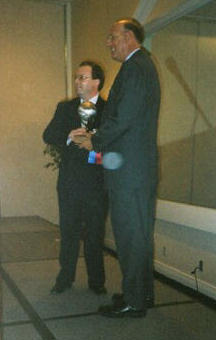We are developing the social individualist meta-context for the future. From the very serious to the extremely frivolous... lets see what is on the mind of the Samizdata people.
Samizdata, derived from Samizdat /n. - a system of clandestine publication of banned literature in the USSR [Russ.,= self-publishing house]
|
In the latest (April 2004 – paper only so far as I can tell) issue of Prospect, there is an excellent letter about private investment in space exploration, from Stephen Ashworth of Oxford, in response to this article by Oliver Morton in the March issue:
Oliver Morton (March) is misleading Prospect readers with his implication that Nasa spaceflight is the only kind that matters. His statement that Nasa’s new direction “marks the end of the era in which the goal of spaceflight is to become routine” will be seen in retrospect as the exact opposite of the truth.
The government space agencies’ monopoly on manned spaceflight is about to be broken. Twenty-seven industrial teams, mostly in North America and Britain, are competing to be the first to fly private passengers to the edge of space in a commercially-operated reusable spacecraft. Their immediate goal is to win the $10m X prize (see www.xprize.org). In America, aircraft designer Burt Rutan is almost ready to claim the prize. In Britain, Steve Bennett’s Starchaser Industries has been building and test-firing large rocket engines and test-flying a reusable piloted capsule, as well as touring schools with Starchaser 4, which in 2001 became the largest rocket ever flown from mainland Britain.
If our civilisation is to make the leap from a one-planet to a multi-planet one, then, just as when it made the leap from a European to a global civilisation, the ultimate drivers will not be government programmes (of Prince Henry the Navigator, Ferdinand and Isabella, Kennedy and Khrushchev). Progress will rather depend upon commercial enterprises which serve public demand (the East India company, the Cunard line, the embryonic space tourist companies).
It would not surprise me if the first astronaut on Mars were not a government employee, but a visionary entrepreneur like Burt Rutan or Steve Bennett, a CEO of a space tourism company with a string of orbital and lunar hotels. That outcome would take much longer than a focused Apollo-style push. But, unlike any past or future Nasa programme, it would not run ahead of the market or the technology in the way that Apollo did.
This letter was worth reproducing in its entirely here not just because it is a good letter, but also because it appeared in Prospect. I like Prospect. It is often leftism, but it is not nearly so often knee-jerk leftism, and often, as here, it is not leftism at all.
I particularly like the comparison between NASA and its political paymasters, and Henry the Navigator and Ferdinand and Isabella. We are told with wearisome frequency nowadays that “technology is moving so much faster these days”, but even the time scales of space exploration have an early navigation feel about them.
It will be interesting to read what Dale Amon has to say about this.
Things have been awfully quiet (officially at least) over at XCOR. They are busy working on their suborbital spaceship design, Xerus is still in early days and remains a paper spaceship. However, unlike many other designs which exist only in POVRAY renderings, the engine technology is real and the team has already proven itself by building and flying and reflying and display flying a rocket plane.
Watch that space.
PS: They are also your fellow Samizdata readers, our ‘home team’ in the X-Prize contest as it were.
Scaled Composites SpaceShipOne has been repaired. As you may remember, the portside gear lock failed and the strut collapsed on landing after the historic first private rocket-powered supersonic flight on December 17th 2003. The recent March 11th test was an unpowered drop test. Beside the reported objectives it is likely they wanted at least one unpowered test to be certain of the gear and airframe repairs. As my flying instructor used to say, the most dangerous time to fly an aeroplane is the day you get it out of the shop at the local FBO.
Objectives: The twelfth flight of SpaceShipOne. Objectives included: pilot proficiency, reaction control system functionality check and stability and control and performance of the vehicle with the airframe thermal protection system installed. This was an unpowered glide test.
Results: Launch conditions were 48,500 feet and 125 knots. All systems performed as expected and the vehicle landed successfully while demonstrating the maximum cross wind landing capability.
According to a ‘knowedgeable aerospace source’, there is still a lot of envelope to test before they get to a ‘hot’ re-entry.
Rutan holds the distance record (non-stop around the world) and will soon hold the alititude record. A speed run would net him the third leg of the triple crown. This makes one wonder if the ablative they are using could handle the severe heat loads of ultra high-speed flight for long enough to allow such a record attempt.
It is perhaps something for Rutan to think about after he wins the X-Prize… and before he sends SpaceShipOne to join Voyager in the National Air and Space Museum.
One of my favourite films, which I watched again last night on my DVD machine, is The Right Stuff. It superbly captures the era spanning the end of the Second World War and the mid-1960s, when test pilots like Chuck Yeager and astronauts like wisecrackin’ Alan Shepherd put their “hides on the line” to test new limits of speed and height in the early parts of the space race. Among the many things that jumps out of this marvellous film, made about 20 years ago and based on the book of the same title by Tom Wolfe, is the almost blase treatment of risk.
Right at the start, when Yeager is testing the Bell X-1, he manages to hurt his ribs through a late-night horseriding incident (he was racing his missus from the pub, like one does in Nevada). Next morning, on the day in which he eventually becomes the first man to officially break the sound barrier, Yeager is in agony. He realises he cannot shut the door on the plane with his right arm because of his injury. So he gets a colleague to cut him a length of stick so he can slam down the door with his only useful arm.
That’s right. The world’s most celebrated test pilot hit Mach One using one functioning arm. Not the sort of thing a modern health and safety bureaucrat would approve of, I am sure.
There is now a web site for the commission which is to create the implementation plan for the new space policy. We would like to see them relying on private sector developments for transport and for lunar exploration and settlement.
Times are changing. We have a major policy opportunity. We can quite possibly move things in our preferred direction: private operation. Although it is lovely to talk about how we would do space exploration in a perfect libertarian society, we do not live in that world. We have to deal realistically with the hand we have been dealt.
I think we have at least a couple pairs going into this one.
There was a documentary about the Royal Navy in WWII on tonight, and one image etched itself into my mind. With a sidescan sonar they found the wreck of the Ark Royal, and along the debris path there was an unmistakeable outline.
A Fairey Swordfish!
This is not just any Fairey Swordfish. This is one of the survivors of Bismark torpedo raids of May 1941. It is sitting at the bottom of the Mediterranean, certainly with all the fabric gone, but still sufficiently intact to give image enough for type recognition.
My mind is boggled at the find and I still find it hard to believe.
I simply cannot wait until someone figures out how to recover it. And if there is one, there might be more. Who knows? Perhaps the very plane that doomed the Bismark will one day grace the Imperial War Museum.

click for larger image
Dana Rohrabacher (R-Ca) has just introduced a bill to clarify language in Federal law relating to commercial human spaceflight.
I must admit there is much about this which truly grates on me as a libertarian. But the realist/entrepreneur side of me recognizes Dana is doing us a good turn. He is easing existing law to make life easier for X-Prize entrants.
Under current law, every launch requires a license. Under the Rohrabacher bill, a single permit appears to cover all flights until the vehicle is ready for commercial operations. Ideally, I would like a single permit to cover all normal commercial operations as well. It seems silly to have vehicles which can take off and fly a suborbital job on a half-day notice and yet require months of effort for the approval to do so. I do not think commercial aviation would have accomplished very much under such a regime. Perhaps we can talk Dana into doing something about this problem when it arises in a year or two.
The other interesting point is his treatment of liability limitation. He has continued the existing law in this area but has laid out a path for removing the government from this loop entirely. My libertarian side would say “get rid of it now”, but my spacer side recognizes the complexity of the insurance issues for the infant field. In a litigous society like the USA, human spaceflight would be uninsurable without this fiat ceiling… despite the fact that a SpaceShipOne or similar craft could do very little damage in the worst of cases. The details of the liability situation would require discussion of FAA regulations which are far too complex for me to reduce to a few bloglines. Let it suffice for me to say US X-Prize entrants are quite happy to have such limitation right now… and I am quite happy to see it phased out as insurance companies become more familiar with the Insurable Risks involved.
I do not have time for a really detailed study of this law. I do know from personal contacts (an ex-staffer for one) Dana Rohrabacher is very familiar with the issues and is pro-commercial space. I have also heard he started off on the libertarian side of the fence but went Republican and drifted a bit out of our quadrant. Still, he is about as good as they come outside of Ron Paul.
The issue is now open to discussion amongst the exceedingly knowledgeable space entrepreneur wing of the Samizdata commentariat.
There are some fascinating (if incomplete) bits of news from the Warbird world this month. The first one really made me sit up at my curry chicken, and it wasn’t because of the spices: a Ju-87 Stuka has been added to the UK civil register! It is another Russian front recovery.
There is very little other information about this as yet. It could be corroded parts at the start of a ten year restoration or it could be in the paint shop and weeks from rollout. Your call.
The other item was quite as stunning, not because of uniqueness, but due to the amazing state of the newly recovered airframe. An Me-109e-7 (upgraded from a -1) has been pulled out of a Russian lake where it landed on the ice 60 years ago. The airframe is in such incredibly good condition that the yellow nose is not only visibly yellow… it is Yellow. I’ve never seen the like of it.
This Emil has been returned in carefuly packed bits to the UK and is now on sale. The project is a real steal for any warbird fan with a million or so burning a hole in their pocket.
 A Bf-109g-6 Gustav at NASM A Bf-109g-6 Gustav at NASM
Photo: Copyright D.Amon all rights reservedThe sheer number of WWII airframes sourced from Russian crash sites over the last decade is nothing short of astounding. It also humbles one. The air battles on the Western Front pale to insignificance when set against the hordes thrown into the aerial meatgrinder of the East.
This post is not going to be about “NASA screwed up, how come after 40 years we still have a space ‘program’ and not a space industry, NASA is drifting off focus and no longer has a clearly defined mission, etc.” I will leave it to someone else to write that column, because Rand Simberg (or our own Dale Amon) could do it a lot better than I could anyway.
What I do want to talk about is: how the way information is organized and presented can make a difference in how it is received – and how bureaucracy can sometimes stand in the way of effective data organization and promote cluttered thinking. When we lost the Challenger in ’86, it should have been clear that it was unsafe to launch the shuttle on that cold January morning. NASA had plenty of data to suggest that it was not prudent to launch that day – the problem is that the data was not refined into a conclusive answer, but rather was shrouded by poor communication and bureaucratic ass-covering.
Edward Tufte, professor emeritus at Yale and author of several brilliant texts on graphic design and the visual display of quantitative data, has made the Challenger accident a centerpiece of his traveling seminar. His exegesis of the Challenger disaster is available in his book Visual Explanations (Graphics Press, 2001).
In hindsight, it was quickly determined what caused the Challenger to fail: the poor cold-weather performance of the rubber O-rings in the field joints that held sections of the solid rocket boosters together. In a memorable session of the Rogers Commission (the group that investigated the Challenger disaster) the late Richard Feynman, Nobel Prize-winning physicist, conducted a dramatic experiment. He affixed a C-clamp to a sample of O-ring material, dropped it into his glass of ice water, and then removed the clamp, revealing that the O-ring rubber lacked resiliency when cooled to 32 degrees Fahrenheit. (See photo below.) → Continue reading: Reflections on NASA’s grim anniversaries
On this day one year ago, the crew of the shuttle Columbia died when their spaceship broke up during re-entry.
Rick Husband
Kalpana Chawla
Laurel Clark
Ilan Ramon
William McCool
Michael Anderson
David Brown

Barry McCool, father of Columbia Astronaut Willy McCool,
accepting a Space Pioneer Award from NSS Board Chairman Kirby Ikin
at the 2003 conference in Palo Alto, California. (PS: Kirby is not a midget!)
Photo: Copyright D.Amon, all rights reserved.
The US bureaucracy’s space branch (NASA) wants to scrap a Shuttle flight to carry out a servicing on the Hubble telescope. A petition has been started by Fernando Ribiero, a Brazilian, to “Save the Hubble“.
As one commenter on the site points out, it is easy for someone living outside the USA to demand that US taxpayers’ money and US lives be risked in a leaky Space Shuttle. For all sorts of American reasons there is a petition but only Americans can sign.
Surely the answer is obvious: privatise Hubble!
I am sure someone could set up a website taking credit card donations to pay for the upkeep of Hubble. Without the NASA inter-departmental bickering, it should be feasible for a few dollars per subscriber a year. I for one would consider this a far preferable use of my money than most government schemes I can think of.
If no trips to service the Hubble telescope are made, it will cease operating by 2007. At some point after that we can assume that the telescope would come crashing down to Earth (statistically not going to do any damage). So the privatisation method I would suggest is that used by the British government to dispose of the Trustee Savings’ Bank in the late 1980s. A price was set, to encourage some sorting out wasters from serious operators and the net proceeds were used to boost the bank’s capital. A variation of this method should keep Hubble up for the next 10 years.
On this day eighteen years ago, seven astronauts on the Space Shuttle Challenger died when their ship broke up during boost.
Dick Scobee
Ellison Onizuka
Mike Smith
Greg Jarvis
Christa McAuliffe
Ron McNair
Judy Resnick
|
Who Are We? The Samizdata people are a bunch of sinister and heavily armed globalist illuminati who seek to infect the entire world with the values of personal liberty and several property. Amongst our many crimes is a sense of humour and the intermittent use of British spelling.
We are also a varied group made up of social individualists, classical liberals, whigs, libertarians, extropians, futurists, ‘Porcupines’, Karl Popper fetishists, recovering neo-conservatives, crazed Ayn Rand worshipers, over-caffeinated Virginia Postrel devotees, witty Frédéric Bastiat wannabes, cypherpunks, minarchists, kritarchists and wild-eyed anarcho-capitalists from Britain, North America, Australia and Europe.
|







